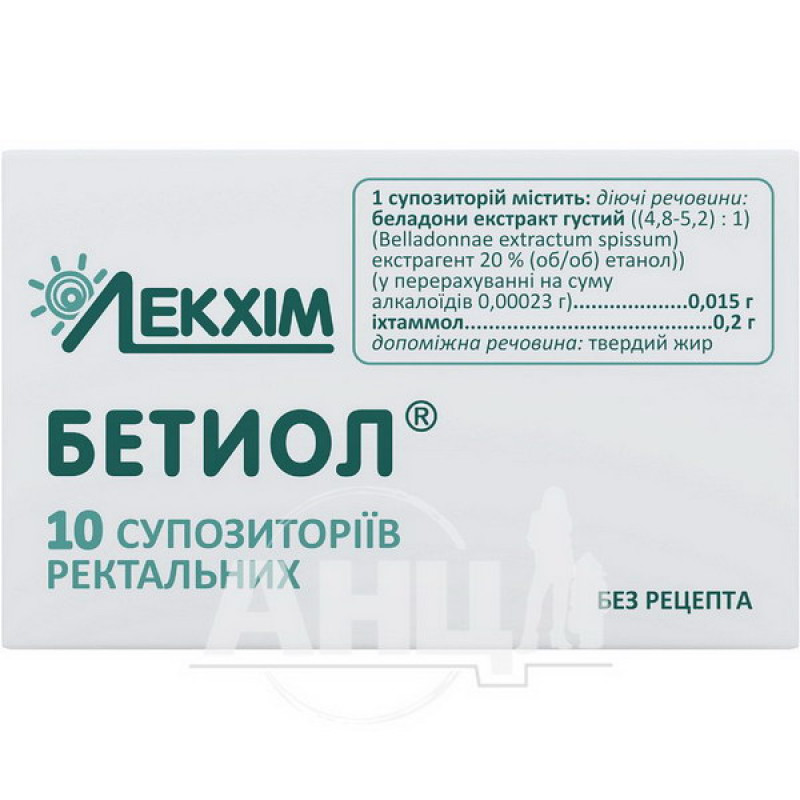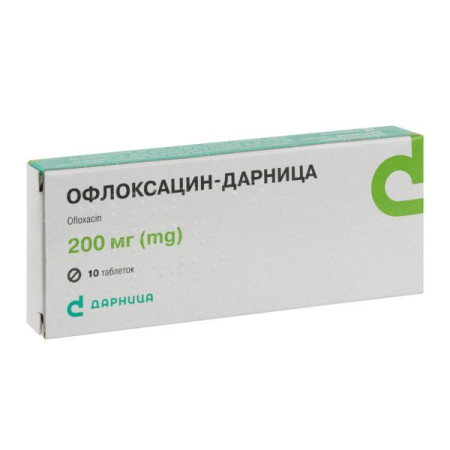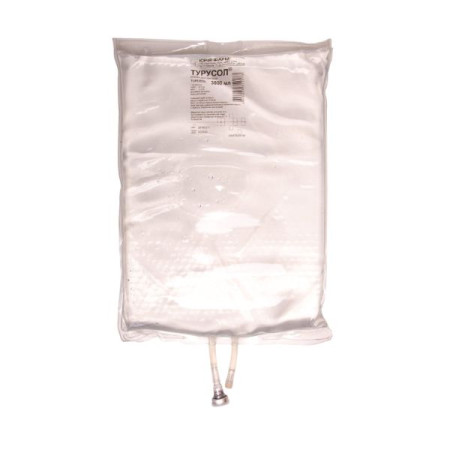Betiol rectal suppositories No. 10

Translation of the instructions can be
BETIOL® rectal suppositoriesInstruction
For medical use of the medicinal product
Bethiol®
(Bethiolum®)
Composition:
Active ingredient: belladonnae extract dense, ichthammol;
1 suppository contains: belladonna extract thick ((4.8-5.2): 1) (Belladonnae extractum spissum) extractant 20% (v/v) ethanol)) (calculated as the sum of alkaloids 0.00023 g) - 0.015 g (15 mg), ichthammol - 0.2 g (200 mg);
excipient: solid fat.
Dosage form.
Rectal suppositories.
Main physicochemical properties: suppositories of dark brown color with a characteristic smell of ichthammol, bullet-shaped. The presence of a coating on the surface of the suppository is allowed.
Pharmacotherapeutic group.
Topical treatment for hemorrhoids and anal fissures.
PBX code S05A X03.
Pharmacological properties.
Pharmacodynamics.
Combined drug for local treatment of hemorrhoids. Has analgesic, anti-inflammatory and antispasmodic effects - reduces spasm of intestinal muscles. Belladonna extract exhibits antispasmodic effects, reduces intestinal peristalsis. Ichthammol has anti-inflammatory and local anesthetic properties.
Pharmacokinetics.
No data.
Clinical characteristics.
Indication.
Hemorrhoids and anal fissures.
Contraindication.
Hypersensitivity to steppe or to other components of the drug. diseases of the cardiovascular system in which an increase in heart rate may be undesirable: atrial fibrillation, tachycardia, chronic heart failure, ischemic heart disease, mitral stenosis, severe arterial hypertension. glaucoma. urinary retention or tendency to it, prostate adenoma. myasthenia gravis. diseases of the gastrointestinal tract accompanied by obstruction. hyperthermic syndrome. thyrotoxicosis. acute bleeding.
Interaction with other drugs and other types of interactions.
When used with monoamine oxidase inhibitors, cardiac arrhythmias occur, with quinidine, novocainamide - an additive anticholinergic effect is observed. may reduce the duration and depth of action of narcotic drugs, weakens the analgesic effect of opiates.
When used simultaneously with diphenhydramine or diprazine, the effect of the drug is enhanced, with nitrates, haloperidol, corticosteroids for systemic use - the likelihood of increasing intraocular pressure increases, with sertraline - the depressive effect of both drugs is enhanced, with spironolactone, minoxidil - the effect of spironolactone and minoxidil is reduced, with penicillins - the effect of both drugs is enhanced, with nizatidine - the effect of nizatidine is enhanced, with ketoconazole - the absorption of ketoconazole is reduced, with ascorbic acid and attapulgite - the effect of atropine is reduced, with pilocarpine - the effect of pilocarpine in the treatment of glaucoma is reduced, with oxprenolone - the antihypertensive effect of the drug is reduced. Under the action of Octadine, a decrease in the hyposecretory effect of atropine is possible, which weakens the effect of M-cholinomimetics and anticholinesterase agents. When used simultaneously with sulfonamide drugs, the risk of kidney damage increases, with drugs containing potassium, the formation of intestinal ulcers is possible, with nonsteroidal anti-inflammatory drugs the risk of stomach ulcers and bleeding increases.
The effect of the drug may be enhanced by the simultaneous use of other drugs with antimuscarinic effect: M-cholinoblockers, antiparkinsonian drugs (amantadine), antispasmodics, some antihistamines, butyrophenone drugs, phenothiazines, dispyramides, quinidine and tricyclic antidepressants, non-selective monoamine reuptake inhibitors.
Inhibition of peristalsis by atropine may alter the absorption of other drugs.
Application features.
Use with caution in patients with prostatic hypertrophy without urinary tract obstruction; with Down syndrome; with cerebral palsy; with hepatic and renal failure; reflux esophagitis; hiatal hernia associated with reflux esophagitis, inflammatory bowel diseases, including nonspecific ulcerative colitis and Crohn's disease, megacolon; in patients with xerostomia; in elderly or debilitated patients; in chronic lung diseases without reversible obstruction; in chronic lung diseases accompanied by low sputum production, which is difficult to separate, especially in debilitated patients; in autonomic (autonomic) neuropathy, brain damage.
Use during pregnancy or breastfeeding.
During pregnancy or breastfeeding, the drug may be used only as prescribed by a doctor if the expected benefit to the woman outweighs the potential risk to the fetus/child.
The ability to influence the reaction speed when driving vehicles or other mechanisms.
When treating with the drug, it is recommended to refrain from driving vehicles or performing work that requires increased attention and precise coordination.
Method of administration and doses.
Adults should use 1 suppository rectally 1-3 times a day. The duration of the course of treatment is determined by the doctor individually, taking into account the nature and severity of the disease and the achieved therapeutic effect. It is allowed to use more often as prescribed by the doctor.
There is no data on the use of the drug in children.
Overdose.
Symptoms: increased manifestations of adverse reactions, nausea, vomiting, tachycardia, decreased blood pressure, agitation, irritability, tremor, convulsions, insomnia, drowsiness, hallucinations, hyperthermia, depression of the central nervous system, depression of the activity of the respiratory and vascular centers, dry mouth, thirst, constipation, dilated pupils.
Poisoning causes delirium with psychomotor agitation, which requires special therapy.
Treatment. Parenteral administration of cholinomimetics and anticholinesterase agents. Treatment is symptomatic.
Adverse reactions.
Gastrointestinal disorders: dry mouth, thirst, taste disturbances, dysphagia, decreased intestinal motility up to atony, decreased tone of the biliary tract and gallbladder.
On the part of the kidneys and urinary tract: difficulty and delay in urination.
Cardiac disorders: palpitations; arrhythmia, including extrasystole; myocardial ischemia.
Vascular disorders: facial flushing, hot flashes.
Neurological disorders: headache, dizziness.
On the part of the organs of vision: dilated pupils, photophobia, accommodation paralysis, increased intraocular pressure.
On the part of the respiratory system and mediastinal organs: a decrease in secretory activity and bronchial tone, which leads to the formation of viscous sputum, which is difficult to cough up.
Skin and subcutaneous tissue disorders: skin rash, urticaria, exfoliative dermatitis, hyperemia.
Immune system disorders: anaphylactic reactions, anaphylactic shock.
Others: decreased sweating, dry skin, dysarthria.
In these cases, the drug should be discontinued and a doctor should be consulted.
Expiration date.
2 years.
Storage conditions.
Store at a temperature not exceeding 25 °C.
Keep out of reach of children.
Packaging.
5 suppositories in a blister, 2 blisters in a pack.
Vacation category.
Without a prescription.
Producer.
Private Joint-Stock Company "Lekhim-Kharkiv".
Location of production and its address of place of business.
Ukraine, 61115, Kharkiv region, Kharkiv city, Severyna Pototskoho street, building 36.
There are no reviews for this product.
There are no reviews for this product, be the first to leave your review.
No questions about this product, be the first and ask your question.





